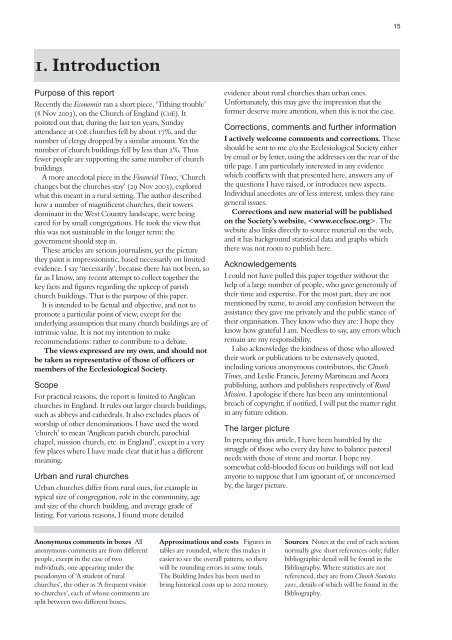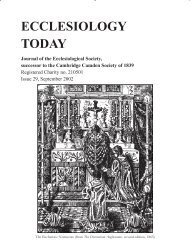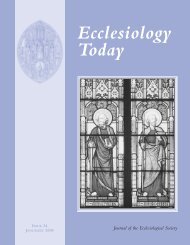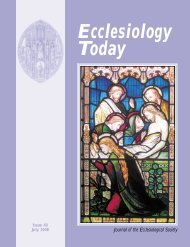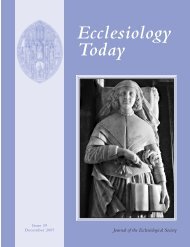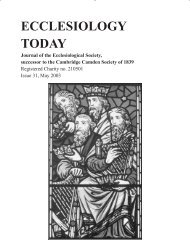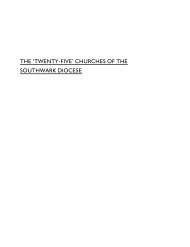PARISH CHURCHES? how do we keep our - Ecclesiological Society
PARISH CHURCHES? how do we keep our - Ecclesiological Society
PARISH CHURCHES? how do we keep our - Ecclesiological Society
Create successful ePaper yourself
Turn your PDF publications into a flip-book with our unique Google optimized e-Paper software.
15<br />
1. Introduction<br />
Purpose of this report<br />
Recently the Economist ran a short piece, ‘Tithing trouble’<br />
(8 Nov 2003), on the Church of England (CoE). It<br />
pointed out that, during the last ten years, Sunday<br />
attendance at CoE churches fell by about 17%, and the<br />
number of clergy dropped by a similar amount. Yet the<br />
number of church buildings fell by less than 2%. Thus<br />
fe<strong>we</strong>r people are supporting the same number of church<br />
buildings.<br />
A more anec<strong>do</strong>tal piece in the Financial Times, ‘Church<br />
changes but the churches stay’ (29 Nov 2003), explored<br />
what this meant in a rural setting. The author described<br />
<strong>how</strong> a number of magni#cent churches, their to<strong>we</strong>rs<br />
<strong>do</strong>minant in the West Country landscape, <strong>we</strong>re being<br />
cared for by small congregations. He took the view that<br />
this was not sustainable in the longer term: the<br />
government should step in.<br />
These articles are serious j<strong>our</strong>nalism, yet the picture<br />
they paint is impressionistic, based necessarily on limited<br />
evidence. I say ‘necessarily’, because there has not been, so<br />
far as I know, any recent attempt to collect together the<br />
key facts and #gures regarding the up<strong>keep</strong> of parish<br />
church buildings. That is the purpose of this paper.<br />
It is intended to be factual and objective, and not to<br />
promote a particular point of view, except for the<br />
underlying assumption that many church buildings are of<br />
intrinsic value. It is not my intention to make<br />
recommendations: rather to contribute to a debate.<br />
The views expressed are my own, and should not<br />
be taken as representative of those of of#cers or<br />
members of the <strong>Ecclesiological</strong> <strong>Society</strong>.<br />
Scope<br />
For practical reasons, the report is limited to Anglican<br />
churches in England. It rules out larger church buildings,<br />
such as abbeys and cathedrals. It also excludes places of<br />
worship of other denominations. I have used the word<br />
‘church’ to mean ‘Anglican parish church, parochial<br />
chapel, mission church, etc. in England’, except in a very<br />
few places where I have made clear that it has a different<br />
meaning.<br />
Urban and rural churches<br />
Urban churches differ from rural ones, for example in<br />
typical size of congregation, role in the community, age<br />
and size of the church building, and average grade of<br />
listing. For various reasons, I found more detailed<br />
evidence about rural churches than urban ones.<br />
Unfortunately, this may give the impression that the<br />
former deserve more attention, when this is not the case.<br />
Corrections, comments and further information<br />
I actively <strong>we</strong>lcome comments and corrections. These<br />
should be sent to me c/o the <strong>Ecclesiological</strong> <strong>Society</strong> either<br />
by email or by letter, using the addresses on the rear of the<br />
title page. I am particularly interested in any evidence<br />
which con$icts with that presented here, ans<strong>we</strong>rs any of<br />
the questions I have raised, or introduces new aspects.<br />
Individual anec<strong>do</strong>tes are of less interest, unless they raise<br />
general issues.<br />
Corrections and new material will be published<br />
on the <strong>Society</strong>’s <strong>we</strong>bsite, . The<br />
<strong>we</strong>bsite also links directly to s<strong>our</strong>ce material on the <strong>we</strong>b,<br />
and it has background statistical data and graphs which<br />
there was not room to publish here.<br />
Acknowledgements<br />
I could not have pulled this paper together without the<br />
help of a large number of people, who gave generously of<br />
their time and expertise. For the most part, they are not<br />
mentioned by name, to avoid any confusion bet<strong>we</strong>en the<br />
assistance they gave me privately and the public stance of<br />
their organisation. They know who they are: I hope they<br />
know <strong>how</strong> grateful I am. Needless to say, any errors which<br />
remain are my responsibility.<br />
I also acknowledge the kindness of those who allo<strong>we</strong>d<br />
their work or publications to be extensively quoted,<br />
including various anonymous contributors, the Church<br />
Times, and Leslie Francis, Jeremy Martineau and Acora<br />
publishing, authors and publishers respectively of Rural<br />
Mission. I apologise if there has been any unintentional<br />
breach of copyright; if noti#ed, I will put the matter right<br />
in any future edition.<br />
The larger picture<br />
In preparing this article, I have been humbled by the<br />
struggle of those who every day have to balance pastoral<br />
needs with those of stone and mortar. I hope my<br />
somewhat cold-blooded focus on buildings will not lead<br />
anyone to suppose that I am ignorant of, or unconcerned<br />
by, the larger picture.<br />
Anonymous comments in boxes All<br />
anonymous comments are from different<br />
people, except in the case of two<br />
individuals, one appearing under the<br />
pseu<strong>do</strong>nym of ‘A student of rural<br />
churches’, the other as ‘A frequent visitor<br />
to churches’, each of whose comments are<br />
split bet<strong>we</strong>en two different boxes.<br />
Approximations and costs Figures in<br />
tables are rounded, where this makes it<br />
easier to see the overall pattern, so there<br />
will be rounding errors in some totals.<br />
The Building Index has been used to<br />
bring historical costs up to 2002 money.<br />
S<strong>our</strong>ces Notes at the end of each section<br />
normally give short references only; fuller<br />
bibliographic detail will be found in the<br />
Bibliography. Where statistics are not<br />
referenced, they are from Church Statistics<br />
2001, details of which will be found in the<br />
Bibliography.


